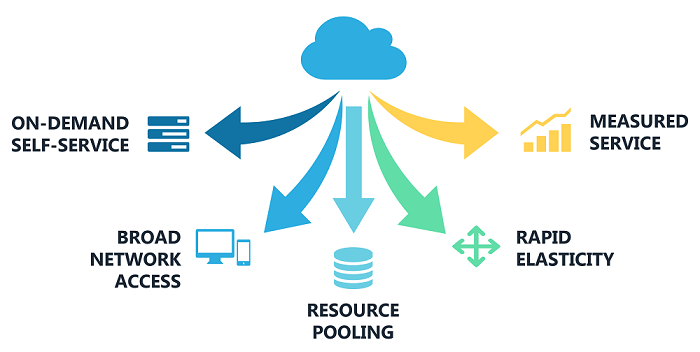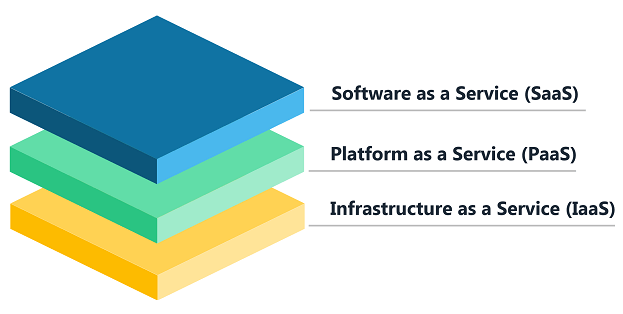Cloud Basics
The first thing to know is that there is no single "cloud." Moving to the cloud isn't as simple as unplugging existing servers and turning them over to a Cloud Service Provider (CSP).
Your organization (e.g., consumer) will need to evaluate your current and future technology needs, and then select the cloud solution that best meets your organization requirements to support your organizations mission.
The Definition of Cloud
The Cloud Information Center (CIC) will use the definition of "cloud" as defined by the National Institute of Standards and Technology (NIST) Special Publication 800-145 The NIST Definition of Cloud Computing
This NIST "cloud" definition is composed of: 5 essential characteristics, 4 deployment models, and 3 service models of a cloud infrastructure.
5 Essential Characteristics

On-Demand Self-Service
A consumer can unilaterally provision the cloud, such as server time and network storage, as needed automatically without requiring assistance form the Cloud Service Provider (CSP).
Broad Network Access
The cloud is available over the network and accessed through standard devices (e.g., mobile phones, tablets, laptops, and workstations).
Resource Pooling
The cloud is pooled or shared to serve multiple consumers, with different physical and virtual resources dynamically assigned and reassigned according to consumer demand.
Rapid Elasticity
The cloud can be elastically provisioned and released, in some cases automatically, to scale rapidly outward and inward based on demand. To the consumer, the cloud infrastructure available for provisioning often appear to be unlimited and can be appropriated in any quantity at any time.
Measured Service
The cloud usage can be monitored, controlled, and reported, providing transparency for both the provider and the consumer of the utilized service (i.e., pay for only what you use).
4 Deployment Models

Public Cloud
Provisioned for open use by any consumer (e.g., business, academic, government). The cloud infrastructure may be owned, managed, and operated by the consumer, a third party, or a combination of them. It exists on the premises of the cloud provider.
Private Cloud
Provisioned for exclusive use by a single consumer. The cloud infrastructure may be owned, managed, and operated by the consumer, a third party, or some combination of them, and it may exist on or off premises.
Community Cloud
Provisioned for exclusive use by a specific community of consumers from organizations that have shared concerns (e.g., mission, security requirements, policy, and compliance considerations). The cloud infrastructure may be owned, managed, and operated by one or more of the organizations in the community, a third party, or some combination of them, and it may exist on or off premises.
Hybrid Cloud
A composition of two or more distinct cloud deployment models (i.e., private, community, public) that remain unique entities, but are bound together by standardized or proprietary technology that enables data and application portability (e.g., cloud bursting for load balancing between clouds).
3 Service Models

Software as a Service (SaaS)
The capability provided to the consumer is to use the provider’s applications running on a cloud infrastructure. The applications are accessible from various client devices through either a thin client interface, such as a web browser (e.g., web-based email), or a program interface. The consumer does not manage or control the underlying cloud infrastructure including network, servers, operating systems, storage, or even individual application capabilities, with the possible exception of limited user specific application configuration settings.
Platform as a Service (PaaS)
The capability provided to the consumer is to deploy onto the cloud infrastructure consumer-created or acquired applications created using programming languages, libraries, services, and tools supported by the provider. The consumer does not manage or control the underlying cloud infrastructure including network, servers, operating systems, or storage, but has control over the deployed applications and possibly configuration settings for the application-hosting environment.
Infrastructure as a Service (IaaS)
The capability provided to the consumer is to provision processing, storage, networks, and other fundamental computing resources where the consumer is able to deploy and run arbitrary software, which can include operating systems and applications. The consumer does not manage or control the underlying cloud infrastructure but has control over operating systems, storage, and deployed applications; and possibly limited control of select networking components (e.g., host firewalls).
Operational Responsibilities
The following graphic illustrates the differences in Operations and Management (O&M) responsibilities between the cloud consumers and the Cloud Service Providers (CSPs) for each cloud service model (i.e., IaaS, PaaS, SaaS).

As indicated in the graphic, consumers and Cloud Service Providers (CSPs) responsibilities are dependent on the cloud service model procured. Understanding this shared responsibility model is fundamental to procuring the appropriate cloud based on your organizations requirements and ensuring appropriate Operations and Maintenance (O&M).
No one cloud deployment model or cloud service model combination is fundamentally better than another combination — each combination offers unique functionality. The selection of a cloud deployment model and a cloud service model combination should be based on the consumer’s requirements. As cloud technologies have advance and consumers have matured their cloud ecosystems hybrid cloud deployment models supporting multiple cloud services models are becoming more commonplace.
